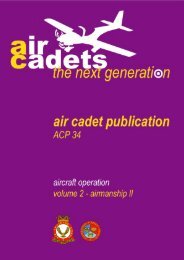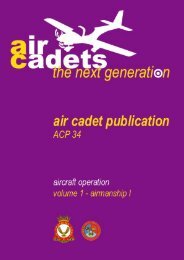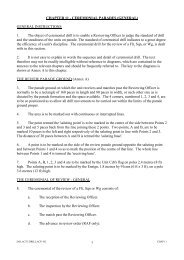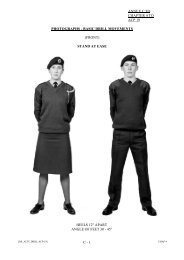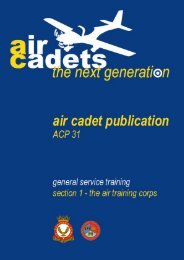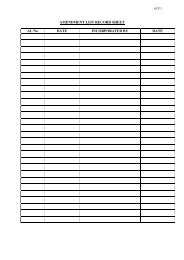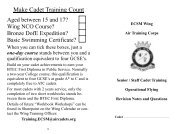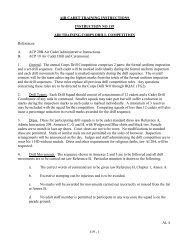Leading Cadet ECSM Wing Revision Guide - 967 Air Cadets
Leading Cadet ECSM Wing Revision Guide - 967 Air Cadets
Leading Cadet ECSM Wing Revision Guide - 967 Air Cadets
You also want an ePaper? Increase the reach of your titles
YUMPU automatically turns print PDFs into web optimized ePapers that Google loves.
Chapter 1<br />
Chapter 2<br />
Chapter 3<br />
Chapter 4<br />
Basic Navigation<br />
Contents<br />
Basic Navigation<br />
The National Grid<br />
Setting or Orientating Your Map<br />
Finding North without a Compass<br />
Magnetic North<br />
Magnetic Variation<br />
Grid Magnetic Angle (GMA)<br />
The Compass<br />
Magnetic Deviation<br />
Setting the Map with a Compass<br />
Setting a Compass Heading<br />
Taking a Bearing from an Object<br />
Roamers<br />
Practical Navigation<br />
Naismith’s Rule<br />
Pacing<br />
Errors<br />
Handrailing<br />
Contouring<br />
Attack Points<br />
Weather<br />
<strong>Air</strong> Masses<br />
Fronts and Depressions<br />
Upper Winds<br />
Anticyclones<br />
Clouds<br />
Flying Controls<br />
The helicopter has four main flying controls:<br />
Collective Pitch Control<br />
The collective pitch control changes the pitch<br />
angle of all the blades of the rotor by the same<br />
amount at the same time and controls the vertical<br />
movement of the helicopter. A cam arrangement<br />
attached to the lever opens the throttle to maintain<br />
RPM for small lever movements.<br />
The Hand Throttle<br />
For large movements of the collective lever the<br />
cam arrangement which maintains engine power<br />
under load is not adequate. In these situations the<br />
pilot will twist the hand throttle located on the end<br />
of the collective lever.<br />
Cyclic Pitch Control<br />
By tilting the rotational disc of the main rotor the<br />
cyclic pitch control is used to make the aircraft<br />
move horizontally. It is normally operated by the<br />
pilot’s right hand like the control column of a<br />
conventional aircraft.<br />
If the stick is moved forward the disc is inclined<br />
forward and the helicopter moves into forward<br />
flight. The stick can be moved in any direction,<br />
tilting the disc in the same direction to move the<br />
helicopter forwards, sideways or backwards.<br />
Tail Rotor Control<br />
The tail rotor, which controls the helicopter in<br />
yaw, is operated by rudder pedals similar to fixedwing<br />
aircraft. Pushing the right pedal forward will<br />
yaw the helicopter to the right and vice-versa.<br />
When the pilot of a helicopter makes a large upwards<br />
movement of the collective lever, more power is required.<br />
How is this extra power obtained?<br />
a) An automatic cam arrangement opens the engine<br />
throttle and no further action is required.<br />
b) The pilot turns the hand throttle to open it.<br />
c) The yaw pedals are operated to increase the load on the<br />
engine.<br />
d) The cyclic pitch is altered taking the load off the tail<br />
rotor.<br />
Where is the hand throttle of a helicopter located?<br />
a) At the top of the joystick.<br />
b) On the cyclic control.<br />
c) On the cockpit wall.<br />
d) On the end of the collective lever.<br />
Tilting the rotor disc of a helicopter forward will make the<br />
helicopter:<br />
a) Travel forwards.<br />
b) Hover.<br />
c) Travel backwards.<br />
d) Climb.<br />
What is the main function of a helicopter's cyclic control?<br />
a) Acts as a rudder.<br />
b) Controls the helicopter's vertical movement.<br />
c) Controls horizontal flight in any direction.<br />
d) Controls the engine speed.<br />
A helicopter pilot uses the yaw pedals to control:<br />
a) The pitch angle of the main rotor blades.<br />
b) Forward speed.<br />
c) Vertical flight.<br />
d) The tail rotor.<br />
26<br />
15



